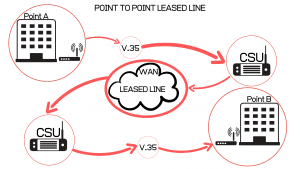What is Point to Point in Networking?
Point to point leased lines are pretty popular these days, and if you’ve been browsing the Leased Line Comparison news and knowledge hub then you probably already know what they are.
We will briefly talk about how a point to point leased line is a private circuit, and a dedicated connection between two points or offices, and we’ll do something a little different as well. We’ll talk about something that’s a little bit less clear – exactly what a point-to-point leased line does.
We all know that it’s important to maintain a connection between two offices operated by the same business, but what we can’t always see is how damaging a shoddy connection can be, and how a point to point can help. So we’re here to provide you with a bit more information about the ins and outs of a point to point lines and help you decide if a point-to-point would be the right option for you.

In a nutshell, a point to point connection:
Maintains Communications
Have you noticed your office getting quieter and quieter? Flexible working is really popular right now, giving employees the chance to work from other offices if they wish. Watercooler banter just isn’t the same, but flexible working is definitely helping to keep up morale and improve satisfaction in the workplace.
With people now working from all over the place, it’s really important to ensure there’s a good connection between multiple sites that need to work together as a team, and a point-to-point leased line does just that it creates a seamless, private connection that removes geographic boundaries.
Point to Point Leased lines connections are also perfect for video conferencing and VoIP calls and transferring data between 2 sites, or you could even create a WAN (Wide Area Network) to communicate between multiple sites or data centres.
Boosts Speed
When you choose to use a dedicated line for your internet connection, you get to choose what speed you’d like usually anywhere between 10 Mbps and 10 Gbps, and it’s no different with point-to-points. You’re in control, you’re in the driver’s seat, and you can select a speed that suits you and ensures that you can transfer files electronically between your sites quickly and easily, and it has symmetrical bandwidth too (same upload speed as download speed).
That means that you get the same speed both ways, so no matter which office is sending and which is receiving, you’ll always get the speeds you want (and speeds you’re paying for).
Improves Reliability
There’s nothing worse than a colleague asking you what you thought of their work, and having absolutely no idea what they’re talking about. But it happens. And it happens all too often. The problem is unreliable connections that mean files don’t always get to where they’re going, much like our luggage on our last summer holiday.
As any good business in the UK knows, reliability is one of the key aspects to success, and point-to-point leased lines can help to ensure that there’s always a reliable connection between the two points. Now if only airlines could use something similar we’d all be happy bunnies.
Compared to broadband connections, Point-to-Point connections are so much more reliable. They are a private Secure network (or private lines if you will), compared to broadband which is a public network, and they are uncontended, and full fibre optic.
Promotes Reputation
Social media is a great invention, isn’t it? It means we can maintain friendships with our friends without actually having to make the effort to go out. But there is a downside to social media: people talk, they talk a lot, actually, and unfortunately, one bad experience with a company can spread like wildfire.
That’s why it’s never been more important to focus on reputation management. Improved reliability and communications between two offices mean that the left hand always knows what the right hand is doing; there’s a reduced risk of miscommunications, helping to keep your clients happy (and quiet).
Prices April 2024
Many people are confused about how much Point-to-point actually cost. In most cases, the are the same price as standard Leased lines. The factors that will affect price are the distance between the two sites, how much speed you need on the line, and if there are any ECC’s.
The distance between the two sites will have a massive impact on the cost, for example, if you have an office in London and an office in Watford, that cost will be somewhat reasonable. But if you have an office in London and an office in Germany, the cost will be considerably more.
Excess Construction Charges occur when there are factors that get in the way of installing the point-to-point line, such as having to shut off a main road or having to halt trains to dig under a track. These charges can add up to hundreds even thousands in some case, but if the charges are too high you can cancel the contract.
The only way you’ll find out if there are ECC’s is by having a site survey, this will be carried out after you’ve signed a contract with your chosen provider, they are normally done by Openreach (BT) or Kelly Communications (Virgin Media), as these two ISP’s provide the tail circuit but other ISP’s will resell that circuit.
If you need more information on how Point to Point leased lines work or are interested in finding the prices for this service, just complete the form on our website, and then one of our friendly advisors will give you a call, run through a few requirements, and get you your quote the same day.
James Ward is CEO & Founder of Leased Line Comparison, a website founded in 2013 and has since helped over 10,000 customers. James gained his expertise in the leased line world by joining a telecoms company called Exponential-e back in 2011 which taught him everything he needed to know to set up this website today. James’ interests include horse racing, skiing, rugby, hiking, boxing and riding. He spends his time between family and friend, socialising and sport.
